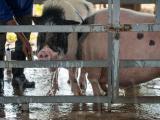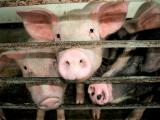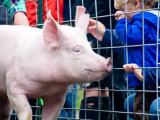Nov 23, 2011 (CIDRAP News) – Testing by the US Centers for Disease Control and Prevention (CDC) has confirmed that the novel H3N2 viruses that recently sickened three Iowa children are similar to swine-origin viruses containing a gene segment from the 2009 H1N1 virus that have been identified in three other states.
The CDC, in a statement late yesterday, said the gene combination was first identified in July and that the Iowa cases announced yesterday raise the total number of human infections to 10. The virus is a swine-origin triple-recombinant H3N2 that includes the matrix gene from the 2009 H1N1 virus.
Unlike the other seven cases, no swine exposure has been identified in the Iowa case-patients, all young children who were in contact with each other, the CDC said. "It appears that unsustained human-to-human transmission may have occurred," the agency said. So far there appears to be no sustained transmission, an event that would raise pandemic concerns.
Of the 10 patients who were infected with the novel H3N2 virus in recent months, 9 were children and one was a 58-year-old, according to Dr. Joe Bresee, chief of the epidemiology and prevention branch in the CDC's influenza division. Besides the three Iowa cases, the recent cases include 2 in Indiana, 3 in Pennsylvania, and 2 in Maine.
CDC officials said previously that the H3N2 reassortant is related to an H3N2 strain that circulated before 1990, so people younger than 20 may be more susceptible to the novel virus than older people are, which could explain why most of the cases have been in children.
But Bresee told CIDRAP News it's too early to reach any conclusions about the reason for the age pattern of the cases. "It's certainly true that adults may be more likely to have some protection against the virus because of previous exposure. But the age distribution with 10 cases could be a variety of things," he said.
Of the three patients who were hospitalized with their infections, at least two had underlying illnesses, Bresee said. He couldn't characterize how sick they were, but he said none needed mechanical ventilation.
Bresee also said the CDC had not identified any links between the case clusters in the different states.
The CDC said that because the virus is so different from human H3N2 viruses, the seasonal vaccine is expected to provide limited cross-protection in adults and no protection in children.
Dr. Patricia Quinlisk, medical director for the Iowa Department of Public Health (IDPH), told CIDRAP News that having been immunized against seasonal flu or sick with flu in the 1990s might have provided a priming effect to the immune system against the novel virus. If that's the case, this year's vaccine may provide a limited boosting effect that could provide some cross-protection, she added.
Health officials are concerned about the limited human-to-human spread, Quinlisk said, though clusters of novel swine-related influenza infections typically pop up, then die out. Over the past several years, Iowa has had three other similar events.
However, she said the IDPH is looking for more cases, and so far no more illnesses have been reported in people who had contact with the three children.
The main message for preventing novel flu is the same as for seasonal flu, especially as Americans prepare to gather to celebrate the Thanksgiving holiday, Quinlisk said. "The big push is to stay home when you're sick."
The CDC said several states have reported the novel virus in swine, but did not identify the states. It emphasized that swine influenza viruses do not spread through contact with pork or pork products and that eating properly handled and cooked pork is safe.
As a routine preparedness measure, the CDC has developed a candidate vaccine virus and provided it to manufacturers, in case the new virus becomes able to spread easily, posing a pandemic threat.
See also:
Nov 22 CDC statement
Nov 22 CIDRAP News story "Iowa reports three novel swine-origin H3N2 cases"
Previous CIDRAP News reports on novel H3N2 cases:
Nov 4
Oct 21
Sep 6
Sep 2


















